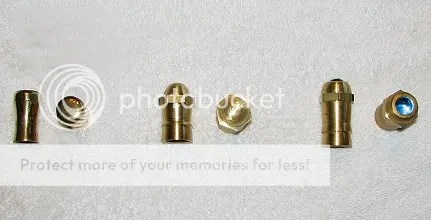Horn knobs are simply pieces of brass that are drilled and tapped on the inside similar to a pipe cap. They are applied to the tips of the horns to keep them blunt. Horn knobs are also quite attractive and give your cattle a distinctive look. Horn knobs are not meant as any sort of protection from an aggressive animal. They are not heavy enough to effect the horn’s growth and, if fitted properly, cause no pain to the animal.

Horns are made up of a bone core covered in a protective sheath. The sheath is made of keratin, the same material your hair and finger nails are made of. At the tip of the horn the sheath forms a solid portion and this is the only area that the knobs effect. Since there are no nerves in this material the knobs are completely painless. Your cattle’s horns must have enough solid keratin before you can properly apply horn knobs. Calf knobs require about a half-inch while larger knobs generally require at least a full inch. This solid portion is usually indicated by a darker color all the way around the horn’s circumference. If you are unsure it is better to wait and give the horn more time to develop.

First:
Secure the animal. While applying the knobs is painless, it will tend to annoy the animal and they will need to hold still. We prefer to tie the animal up but rather than trying to fully restrain their head with ropes or straps, we have a partner physically restrain the head by standing against their neck and pulling their neck around. This along with frequent rest breaks seems to make the process a little better for them.
Second:
Mark the horn to show where the knob will fit. Masking tape makes a good marker. Also when laying it out a few things must be considered. The knob will look its best and last the longest if it fits either flush with the horn or if the horn is slightly proud of the knob when finished. The more length of horn you can leave inside the knob the more secure the knob will be. In the case of fitting a close ended knob on a long slender horn it may be necessary to trim some of the length of the horn so that the knob doesn’t bottom out before it fully seats. You will need to eye-ball it so that the knob is straight when finished.

Third:
Using a pocket knife and file very carefully, carve and file the end of horn into a peg that will perfectly fit the knob. Preferably this peg will have a 90 degree shoulder at its base. This shoulder will be the natural size of the horn and again it is best if it is either the same diameter as the knob or slightly larger. It is extremely important that you do not remove too much material at this point. You can use a wrench to screw the knob on to check your progress. If the peg is the proper size the knob will screw down the peg cutting its own threads into the horn. If the knob doesn’t screw down the peg then the peg is likely to thick or too long if fitting a closed ended knob. If the resulting threads are light or missing, then the peg is too small or out of round. When the knob will screw completely down and seat against the shoulder you carved, it is fitted. Be careful not to strip the threads of the horn by over-tightening.

Fourth:
Once you are happy with the fit of the knob remove it one last time. Apply a quality epoxy to the treads of both the horn and the knob and screw the knob back on. Don’t be overly concerned about any excess epoxy that may leak out onto the horn. The animal will quickly rub it off on its own. If you fitted a closed-ended knob, then your task is now complete. If you fitted an open-ended knob, then cut off the protruding tip of the horn and then your task is complete.

If you have done a proper job you should enjoy your new horn knobs for many years. Over time you will notice wear and tear on both the brass knob and the horn at the base of the knob. Eventually, over several years, the horn at the base of the knob will be worn thinner and thinner untill the knob breaks off. It is then time to start over with a new set of horn knobs. How long they will last is unpredictable because cattle work their horns down at different rates.
